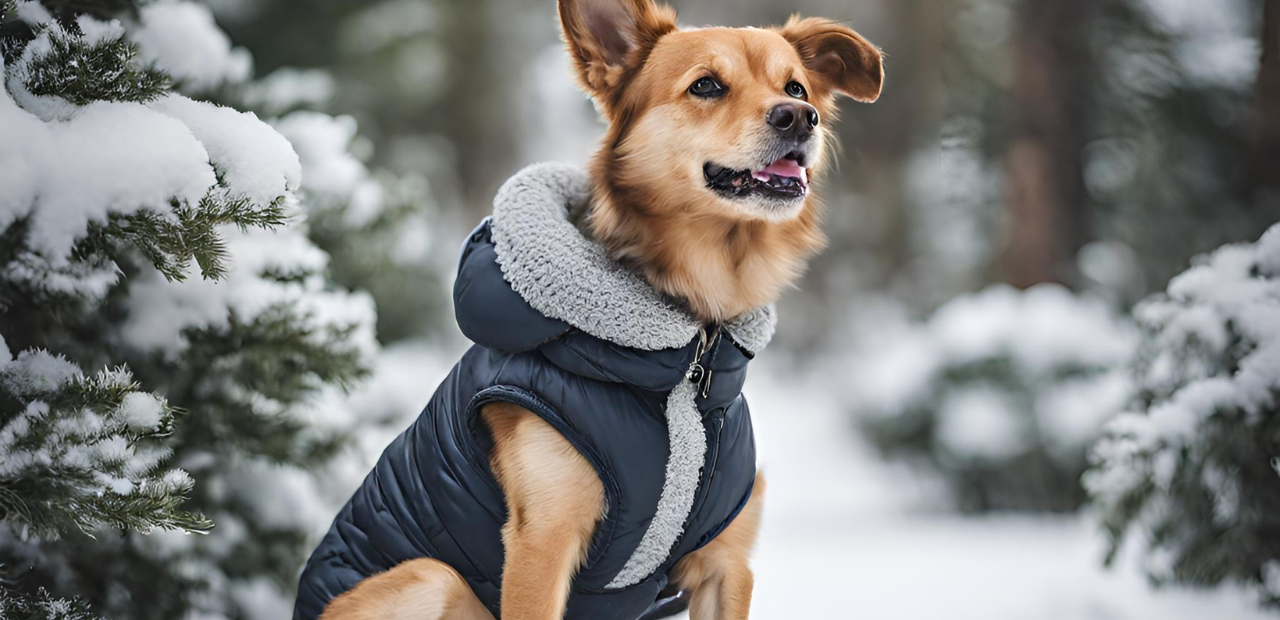As the chilly winter season approaches, you might wonder how to keep your furry companion warm and stylish during outdoor adventures. Our guide to winter dog fashion is here to help you navigate the frosty temperatures with flair.
Importance of Winter Wear for Dogs
As we bundle up to face the frosty temperatures, we should extend the same courtesy to our canine friends. The importance of winter wear for dogs cannot be overstated—it’s not only about them looking cute, but primarily about ensuring their comfort, safety, and overall well-being during the colder months.
Protecting Against Cold and Wetness
When it comes to dressing your pup for winter, it’s not just a fashion statement. It’s necessary to protect them from the cold and wet weather conditions. Depending on their breed, age, and health, dogs can lose body heat quickly. There are even cases where they can get cold injuries.
A good waterproof or water-resistant winter coat can keep your dog dry. It can help them in snow or in wet weather. This is essential because wet fur can make them feel colder and can lead to hypothermia. So, always make sure your four-legged friend is properly dressed before any winter walks or playtime outdoors.
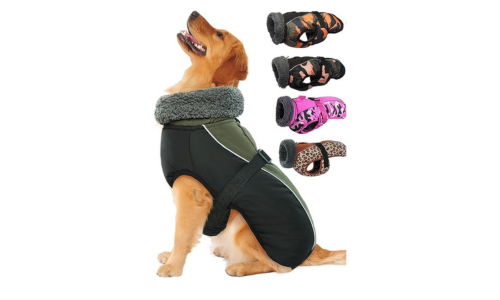
Maintaining Comfort and Safety
Just like humans, dogs too need to be comfortable to enjoy their time outdoors. Ensuring your dog’s comfort starts with recognising what might make them uncomfortable. Damp fur, chilly winds, icy sidewalks or even accumulated snow on their paws can cause discomfort, irritability, and even health problems such as frostbite or hypothermia.
So, how can you maintain your dog’s comfort and safety? Wearing appropriate winter gear. Quality winter gear for dogs isn’t just about looking adorable. It protects your pet’s skin and paws from rough weather conditions. It acts as a barrier, keeping the cold out and the warmth in. Importantly, it also keeps your dog dry, is crucial for maintaining body temperature.
But remember, every dog is unique. What works for one may not work for another. Understanding your dog’s breed and size, their tolerance to cold, and any existing health conditions will help you make the best choice for them.
Understanding your Dog’s Needs
Before bundling up your furry friend in warm clothes, it’s crucial to understand their specific needs. Different dog breeds react differently to cold weather, and factors such as size, health, and behavior can largely influence the ideal winter wear for your pup. Now, let’s explore those aspects in detail.
Consideration for Size and Breed
When it comes to dressing your canine companion for the cold, their size and breed can play a significant role. Not all dogs are built for the winter. Tiny breeds or those with short fur such as Chihuahuas, Pugs, and Greyhounds may struggle to maintain body heat in cold temperatures. These pups could use a bit more insulation.
Larger breeds or those with thicker fur, like Saint Bernards, Malamutes, and Huskies, are naturally designed to withstand chilly climates. But that doesn’t mean they can’t benefit from winter wear. Even a moderately cool day can still result in wetness from rain or snow, which could lead to discomfort for any breed.
Remember, the right winter wear should fit your dog’s breed and size perfectly. So it’s vital to consider this when preparing your pupper for winter excursions.
Behavioral and Health Factors
When considering winter wear for your dog, it is crucial to understand their behavior and health condition. Behavioral traits such as activity level, outdoor time, and tolerance to low temperatures should play a role in the clothing decision process.
For instance, dogs who are extra playful or spend significant time outdoors may require more robust protection against the harsh weather elements. Furthermore, a dog’s health condition such as old age, medical conditions or certain sensitivities can also influence their ability to withstand cold weather.
Always consult a vet if you’re unsure as they can guide you on what’s the best approach based on your pet’s specific needs.
Options for Dog Winter Wear
Making sure your four-legged friend is warm and comfortable in the winter season is a top priority. The good news is, there are numerous options for dog winter wear on the market, each designed to suit different needs, breeds, and environments. Whether it’s a waterproof jacket, fleece-lined sweater, or a pair of durable booties, each has its own unique set of benefits and uses. In this section, we’ll explore several types of winter wear, so you can find the right fit for your pooch.
Coats and Jackets
As the temperature drops, a well-insulated coat or jacket can become your dog’s best friend. Not only does it keep their body temperature stable, but also shields them from harmful elements like icy rain or sharp wind.
Different coats and jackets come with a variety of features. Some have waterproof exteriors that make it easier for your fur-friends to shake off the wetness. Other models may incorporate reflective strips for better visibility in lower light.
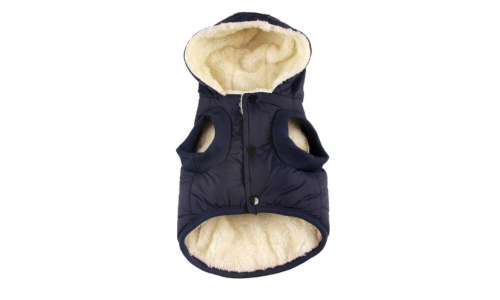
Remember, it’s essential to pick a coat or jacket that fits your dog snugly while allowing room for movement. As a dog owner, investing in such outerwear can go a long way in keeping your canine companion comfortable, warm, and safe in winter.
”The most important job of a dog’s winter coat is to keep the body warm by trapping body heat.”
Boots and Paw Protection
Winter can be a harsh season, not just for us humans but for our furry friends as well. Dog’s paws can become sensitive to the cold and to the rough textures of ice or hard-packed snow. In worst cases, harsh winter chemicals can injure your dog’s paws.
To protect your dog from these hazards, consider investing in boots or paw protection. These can keep your dog’s paws warm and safe. They also shield the paws from salt and chemicals used to melt snow on roads and sidewalks.
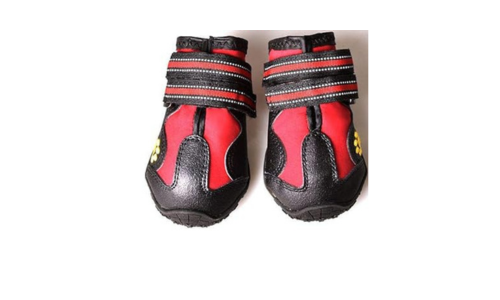
Quality winter boots come in various sizes and styles. It’s a good idea to find one that fits your dog comfortably and snugly. Some even have anti-slip properties for keeping your dog steady on slippery surfaces.
In a case where your canine buddy isn’t comfortable with boots, opt for paw balms or waxes. These provide a protective layer on your dog’s paws against cold and chemicals. Don’t forget to routinely check your dog’s paws for any signs of cracking or injury. With the right boots or paw protection, your dog’s paws will thank you for a warmer, safer winter.
Knitwear and Sweaters
If you’re looking for a cozy yet practical winter solution for your pooch, knitwear and sweaters are a classic choice. They are especially suitable for small-sized or short-haired dogs that require an extra layer of warmth.
These delightful pet wears come in various sizes, patterns, and materials. However, the most popular ones are the wool or acrylic types because of their significant insulation property. Sweaters provide warmth and tend to cover more of your dog’s body, offering more extensive protection against the cold.
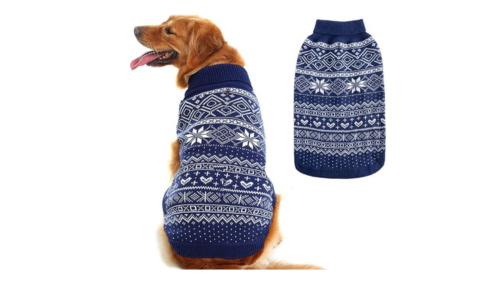
When investing in knitwear, consider a design with a high-cut waist to ensure it won’t interfere with your pet’s…you know, outside business. Furthermore, ensure the knit is tight to stop their claws from snagging into it during playtime.
In conclusion, with a ideal sweater or piece of knitwear, your dog doesn’t have to miss out on any winter fun due to the cold.
Accessories and Extras
Apart from the primary winter wear, additional accessories can add an extra layer of protection for your dog. These might include scarfs, hats, and even pet-friendly sun creams for those winter sun days. Remember, these extras are not just about making your pup look cute, but they should also provide a function, such as keeping your dog warm.
Like other types of dog winter wear, make sure any accessories are the right size for your dog and are comfortable. Don’t forget to monitor your furry friend while they’re wearing accessories. Some dogs might try to chew or pull them off, which could potentially lead to a choking hazard.
Choosing the Right Winter Wear for Your Dog
When winter comes around, your four-legged buddy requires some extra care. This goes beyond more snuggles and include crucial factors like choosing the right winter wear for your dog. Let’s explore how you can pick out the perfect winter gear to keep your furry friend warm and comfortable.
Material and Insulation
Choosing the right material for your pooch’s winter wear isn’t just about fashion. It’s also about keeping them cozy and warm during those frosty winter walks. Some of the warmest materials for dog winter wear are fleece and down. Both offer excellent insulation, helping keep your pup’s natural body heat in.
But warmth isn’t the only factor to consider when it comes to materials. Notably, winter dog wear should be water-resistant, or better still – water-proof. That’s because damp clothing can make your dog colder, and wet winter conditions can quickly saturate non-resistant materials. Consider items with outer layers made from materials like nylon, as they have good water resistance properties.
Lastly, ensure the material chosen does not irritate your dog’s skin. Some breeds may not react well to certain fabrics. Hence, go for something lightweight, soft, and non-irritating like cotton for the inner lining. Always observe your pet’s behavior after wearing new clothes. If there are any sign of discomfort, it might be the wrong material for them.
Remember, a well-insulated and comfortable outfit is crucial for your pooch’s winter wellbeing!
Proper Sizing and Fit
When it comes to choosing winter wear for your pup, proper sizing and fit are essential. Just like people, canines come in a variety of shapes and sizes, so it’s crucial to find gear that fits your fur pal perfectly.
A poorly fitting garment won’t provide adequate protection, and it may even make your pet comfortable or pose a safety risk. Be sure to measure your dog correctly before purchasing any winter gear.
Use a tape measure to gauge your pet’s neck girth, length from neck to tail, and chest girth. These measurements will help you find pet apparel that fits snugly but isn’t too tight.
Remember, the gear shouldn’t impede your pup’s ability to move or breathe. Always check the manufacturer’s sizing guide before making a purchase, as sizes can vary between brands.
“How to Measure Your Dog for Clothing,” (https://www.petmd.com/dog/slideshows/how-measure-your-dog-clothing?view_all=1) PetMD.
Mobility and Comfort
When choosing the right winter wear for your dog, two key factors to consider are mobility and comfort. It’s not enough for clothes to simply keep your furry friend warm; they should also allow your dog to move freely.
Garments that are too tight can restrict movement or cause chafing. On the other hand, clothes that are too loose may not provide adequate protection from the cold. Therefore, it’s crucial to find winter outfits that blend the warming benefits of winter wear with a comfortable fit that caters to your dog’s unique body shape and size.
Remember that comfortable winter wear can increase your dog’s enjoyment of winter walks and outdoor play, making these experiences more positive for both of you. After all, a happy, comfortable dog makes for a happy pet parent.
Winter Care Tips for Dogs
When the chill of winter arrives, it’s imperative to keep a keen eye on the welfare of our four-legged friends. Why? Well, altering care routines and considering a few extra precautions can make all the difference to your dog’s health and happiness. These winter care tips for dogs focus on essential considerations – paw checks, limiting outdoor exposure, and balanced nutrition and hydration.
Regular Paw Checks and Care
Your dog’s paws are in direct contact with the icy, snowy ground in winter. Because of this, they can suffer from dryness, cracking, or even painful ice balls between their toes. Regularly checking your dog’s paws is crucial to ensure their comfort and healthiness.
A paw check includes overviewing for any cuts or cracks, and removing ice or snowballs that may be stuck. If the pads are dry or cracked, use a dog-friendly moisturizer to soothe them. Never use human lotion; they may soften the pads too much, making them prone to injury. Always remember, a dog’s paws give them the necessary grip they need for their everyday adventures!
Limiting Outdoor Exposure
In certain conditions, exposure to the chilly elements can be too harsh for our furry friends. The winter frosts can pose a risk, regardless of the level of your dog’s winter wear. Snowy pathways and frosty parks may look appealing, but can lead to discomfort and could potentially have a negative impact on your pet’s health.
Therefore, it’s wise to monitor and limit the duration of your dog’s outdoor activities during the winter. When the weather is particularly severe, consider shortening your regular walks, and always ensure they’re adequately protected with their winter gear. Also, bringing toys and engaging in playful activities indoors can make staying in more enjoyable for your dog. After all, safety should take precedence over outdoor fun.
Balanced Nutrition and Hydration
In the frigid winter months, your dog’s nutritional needs can change. It’s crucial to provide balanced meals to keep them energized and warm. Some dogs may even require more calories in the winter to generate body heat. Try to include high-quality proteins, carbohydrates, and fats in your pup’s winter diet.
Hydration is another vital element of winter dog care. Just because it’s cold outside, it doesn’t mean your dog needs less water. Always ensure fresh and clean water for your dog, preventing the water from freezing if outdoors. Dehydration can lead to various health issues, including dry skin, which can be a severe problem in winter’s dry air.
Conclusion
With the right winter wear, your dog can enjoy the cold season alongside you, ensuring they’re warm, safe, and stylish while having outdoor fun.
- Smelly House Because of Dog? Take These Hygiene Tips - May 20, 2025
- How to Introduce a Dog To a Cats Without Chaos - May 6, 2025
- 4 Best Cavapoo Rescues in the UK 2024 - April 5, 2024
